The Cleanup of Black Rock City: It's All About the "MOOP" |
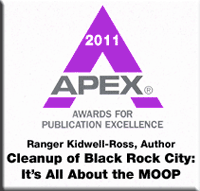 |
This article won an APEX Award for Publication Excellence in a national U.S. competition. For more information about other APEX Award-winning articles on the WorldSweeper.com website, go here. |
Over time, I have traveled extensively to bring our readers information about unusual cleanup efforts and methods in a wide variety of places around the world. The sweepers used to clean hay from the roads in Switzerland and the underground, storage-based cleaning methods in the walled city of Evora, Portugal come immediately to mind. To say nothing of cleaning up after Mardi Gras or New Years at Times Square.
However, the following article catalogues what may be the most astounding cleanup effort I've covered to date. The Black Rock City DPW's challenge is to remove all Matter Out Of Place, or "MOOP," so as to restore a large stretch of harsh desert to 'Leave No Trace' standards after 50,000+ people live there for a week.
by Ranger Kidwell-Ross
Most of our articles are designed to provide you with information you can use to make your own sweeping efforts more thorough, more cost-effective and run more smoothly. Occasionally, though, I like to offer an article designed to inspire readers to realize what is possible. In this case, my hope is that our WorldSweeper.com readers will use what they read as an allegory that inspires them about what they might accomplish in their own locales.
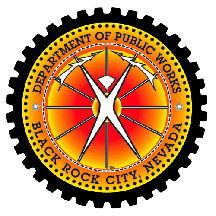
The Black Rock City Department of Public Works showcased in the following story faces a cleanup challenge few city managers can even comprehend. After many weeks of preparation by a mostly all-volunteer staff in one of the most forbidding desert landscapes in America, up springs Black Rock City, Nevada, site of the legendary event called "Burning Man."
Almost overnight more than 50,000 people move in to the highly organized and platted-out space that has been prepared for them. Then, a mere week later, when attendees leave town not to return for another year, DPW's team dismantles any remaining City structures and restores the entire area.
Because Burning Man is known as the most successful cleanup and restoration of any United States' event monitored by the U.S. Bureau of Land Management (BLM), I have long had a professional interest in seeing how it's done in person. You see, not only are 50,000+ people camped for a week with no food or other items being bought or sold; even more astonishing, no trash disposal whatsoever is provided or available.
At the Burning Man event there is also no exchange of money except for purchase of coffee and tea beverages at the center camp along with the sale of bags of ice. The latter benefits the local area school system. Because of the event's harsh environment and remote location, along with the Burning Man concept of personal self-reliance, participants are expected to be responsible for their own welfare in all regards.
With a scant 72 hours notice I received an opportunity to attend Burning Man this past Labor Day when my friend Tom, who is a Seattle Fire Chief, was unable to go at the last moment. As an added enticement for a 'newbie' like me, Tom was still able to arrange for our four-person group to be able be part of the camp of the fire department personnel in charge of fire safety. It was an opportunity I simply could not pass up. However, those three days of preparation were some of the most intense I've experienced. Yet they would soon be eclipsed by the event itself.
The Making of Black Rock City
Since 1990 the annual Burning Man event has been held in the Black Rock Desert of Northern Nevada. Historically, the event starts on the Monday before, and ends on the day of, the American Labor Day holiday. Burning Man derives its name from the ritual burning of a large wooden effigy on Saturday evening. Organizers describe the overall event as "an ongoing experiment in community radical self-expression, along with the added credo of radical self-reliance."
Black Rock City is the name given to the area enclosed during the time of the Burning Man event. This year, 52,000 tickets were sold. The first couple thousand early birds paid just over $200 per ticket. Pricing then escalated with tickets sold, with a price of $360 for anyone purchasing at the gate. Although that may seem a bit expensive for an opportunity to camp in an unforgiving desert for a week, where no amenities are included except porta-potties (sometimes called "blue saunas" or other colorful names, like "yam factories") and the opportunity to buy ice, tea and coffee, the high ticket price provides organizers with the millions of dollars needed to put on the event.
Black Rock City's Department of Public Works' members spend weeks on the open desert of the dry Black Rock Lakebed – called the playa – in preparation for the arrival of the masses. In the weeks preceeding the onslaught of attendees, DPW builds out the approved city plan using traditional survey equipment. The entire area is gridded out and marked with survey flags planted into the playa surface.
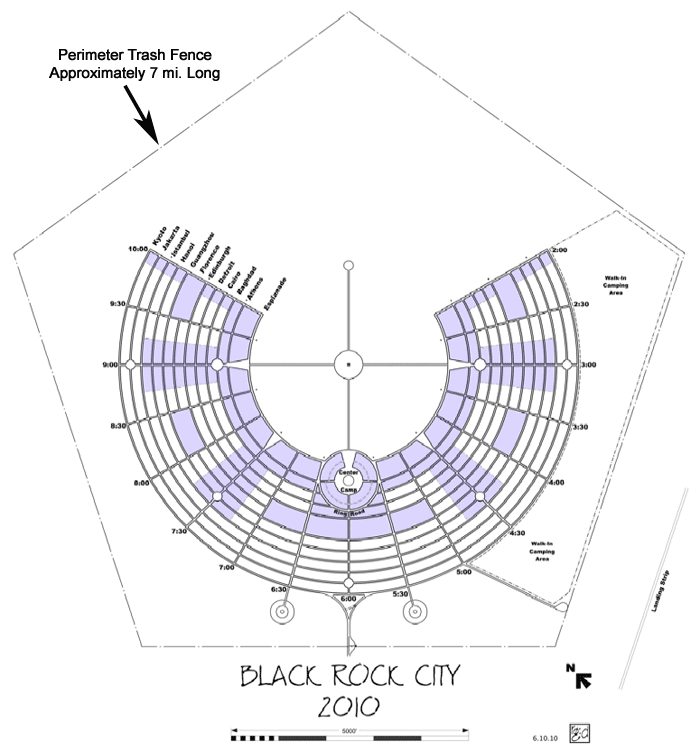
The layout is so well done that getting around is relatively easy, even given the event's enormous size. As you can see, the horseshoe-shaped layout is numbered like a clock along the outer perimeter, starting with 10 at the upper left and ending with 2 at the upper right. Six o'clock, at the bottom, is the center. All of the cross streets are given names in an alphabetical order. However, I'm getting ahead of the story...
Education and Preparation for Camping in the Black Rock Desert
Imagine, if you will, my harried preparation as I tried to consider and then procure everything I would need for a week of tent camping in the open desert. I was told to prepare for daytime temperatures above 100-degrees, nighttime temperatures in the 40s, and winds that could exceed 75 mph. And, as was emphasized repeatedly everywhere I looked, the dry lake bed of Black Rock Desert is composed of sand that actually has the fine consistency of talcum powder. When the wind blew, and be sure it would, I had to be immediately ready for white-out conditions that might last for hours.
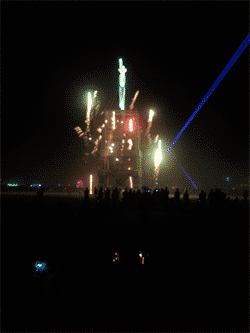
Fortunately, I had the advantage of traveling with three veteran Burning Man attendees. Long-time friend and building contractor, Aviathar Pemberton, I knew to be a capable person in all regards. His son, Quan, was flying in from Bahrain, where he is currently teaching. Quan's friend, Sarah (also named Pemberton but no relation), was doing the same from her home in London, where she is an accomplished actress and executive producer.
Another big plus was that we were invited, even in Tom's absence, to remain a part of the Burning Man Volunteer Fire Department enclave. "You might," Tom said knowingly, "even be able to take a sun shower or two during the week." Another significant spiff of fire camp, I learned, was that for an extra $75 apiece we could be part of the Department's community kitchen. You bet!
As it turned out, our primary contribution to the camp was to help prepare two meals each day, along with the other non-fire trained campmates. Most of our camp, however, was composed of very experienced fire personnel from around the nation. Without exception, these were some of the most quality individuals you could ever be so fortunate as to spend time around.
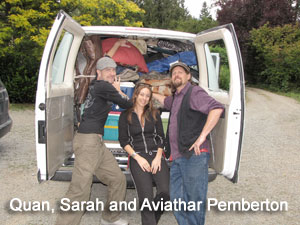
In addition to all creature comforts and survival/safety gear, the four of us had to have on board the snacks and other food we'd need, as well as the minimum 35-gallons of drinking water that we'd consume. Our 800-mile commute by our 4-person team was done in a rented 12-passenger van, which was completely jammed when we hit the road. Prior to leaving, savvy contractor Aviathar got a roll of self-sticking plastic with which we lined the entire interior of the van. That made eventual cleanup much easier.
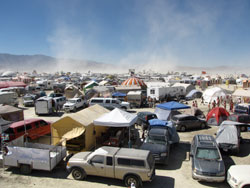
I was challenged with preparing for an outdoor environment harsher than any I'd ever before experienced. To get prepared as thoroughly as possible, as soon as I knew I was going I read information online – for more than four hours. Much of the available information stressed a large number of "must have" items for survival.
Many of the websites emphasized that readers needed to take what might seem like outlandish safety recommendations seriously; for example, having all the gear needed during dust storm white-outs could mean the difference between life and death. The photo you see to the left was taken at the event during a mild dust-up caused by only about a 20 mph wind.
Along the way, I also learned that participants are encouraged to participate in unconditional gifting – what Native Americans called "potlatching" – and that my clothing should be primarily composed of 'artistic outfits' in order to participate with everyone else. For my 'potlatch giveaway items' I took along about ten pounds of Mardi Gras beads I had on hand thanks to my friends at Louisiana-based Clean Sweep, Bridget and Warren Burge.
Burning Man Finances and Infrastructure Logistics
The total budget for Burning Man has grown to in excess of $10 million per year. Of this, over $1 million is paid to BLM as a usage fee. Other hefty line items include insurance, law enforcement, medical teams; the categories go on and on.
Just the rental and service fees on the more than 1,000 porta-potties for ten days run over half a million. There are also quite a few behind-the-scenes amenities that aren't obvious to attendees. For example, this year it was in the range of $200,000 just to rent the walkie talkies in widespread usage by all levels of support teams. Because of the aforementioned insidious playa dust, it takes days just to clean the units so they're returnable. Although the 2010 final budget numbers are not in as of publication, you can get an idea of what's typical by looking at the 2009 budget figures, which are available online.
It's All About the Art... and the Burns
Over $300,000 is spent in art grants. This money is enough to commission some of the most fantastic art pieces imaginable. These displays are scattered throughout the expansive Black Rock City landscape, commonly called 'the playa.' Although I've included a number of art pieces in the animated photos you see, they represent only a very small sub-set. And, the sheer scale is impossible to convey through photography.
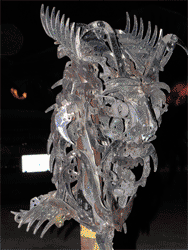 |
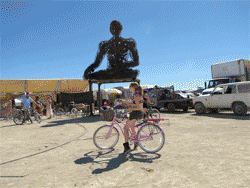 |
Along with the stationery pieces, some of which approach 100' in height, are a host of 'mutant vehicles' that constantly roam the area. These are juried ahead of time, and only a select few dozen gain the coveted permit that allows them to be driven on the playa. The mutant vehicles range in size from golf cart chassis-based machines to enormous driveable structures on who knows what type of truck or purpose-built chassis, including the 60' Chris Craft boat you see in one of the photos.
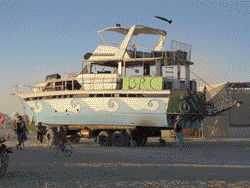
Sometimes, especially since nighttime is when all the action takes place, it was hard to tell whether something you'd see was an in-place art piece or a mutant vehicle. At one point I spotted two art pieces, each at a distance of perhaps 100 yards but located in slightly different directions. I went off on my bicycle to see the towering twinkling pod-like items first, leaving the two-story structure covered with dancers on the roof for second. After enjoying the first art sculpture, I discovered to my astonishment that what I mistook for a building was actually a mutant vehicle that had driven away!
The other main theme of the event is fire, Fire, FIRE! Many of the mutant vehicles were equipped with astounding fire features. A standard methodology was to have a two-inch pipe connected to a standing pilot light and a propane tank. Pulling a lever opened the propane valve to emit an astonishing blast of pressurized flame into the heavens.
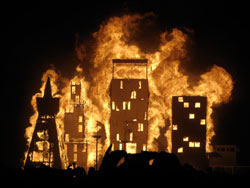
Plus, large-scale, highly planned conflagrations take place at scheduled times throughout the week. The largest of these were Friday night's MEGATROPOLIS, Saturday night's namesake Burning Man sculpture, and the burning of the spiritual Temple on Sunday night. Shown to the left is a shot I took during the MEGATROPOLIS burn on Friday. If you want to see a two-minute YouTube video snippet of the burn as it occurred, click on the photo.
Although before I went I had a keen interest in seeing the art I'd heard so much about, my main mission at Burning Man was to investigate how the cleanup would be accomplished. And, of course, to bring an unusual story back for WorldSweeper.com readers.
Although many of the annual theme camps are astonishingly large and complex, replete with a host of multi-story structures and sprawling sub-encampments, everyone's mandate at week's end was to completely disassemble and remove their camps – as well as take absolutely everything they had brought away with them – a concept called "Leave No Trace" (LNT). A subset of the Burning Man organization mandated with making sure the LNT guidelines are met is called "Earth Guardians." Earth Guardians, in turn, has incorporated the guidelines already in place by the national organization called 'Leave No Trace.' More on Earth Guardians further on.
Although zero debris left behind by all is the goal, that is, of course, not actually 100% attainable. I set out to find out if there was an established benchmark of allowable debris an annual theme camp was allowed to leave and still pass inspection. What I learned during my investigation was astonishing: The debris left behind per acre by any of the many theme camps could not exceed what would fit onto a 9-inch paper plate!
If those exacting standards are not met by one of the annual camps, that camp's organizers are required to come back and re-clean in order to get their camping permit for the next year. Oh, and half of the material on the plate has to be wood or paper, not glass, metal, plastic or other material.
Black Rock City Cleanup and Playa Restoration
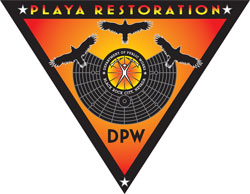 It's hard to convey the vast amount of land that comprises Black Rock City. As of 2004, the temporary city was considered to be the 10th largest city in Nevada. Without a bicycle it would be extremely hard to see even a 10th of the art. Even with my mountain bike along I probably saw only 30% to 35% in the entire week I was there, even though I tried to set off in a different direction each time I went for a ride.
It's hard to convey the vast amount of land that comprises Black Rock City. As of 2004, the temporary city was considered to be the 10th largest city in Nevada. Without a bicycle it would be extremely hard to see even a 10th of the art. Even with my mountain bike along I probably saw only 30% to 35% in the entire week I was there, even though I tried to set off in a different direction each time I went for a ride.
The cleanup to LNT standards is a daunting task by anyone's standards. As a preventive, a 7-mile-long temporary plastic surround fence is erected as part of the DPW's preparation plan. The fence effectively defines the perimeter of land used, all of which is located on the southern edge of the a dry lakebed in the Black Rock Desert. This four-foot-high barrier is known as the "trash fence" because it is deployed to snag any windblown debris that might escape from campsites during the event.
In 2010, the Black Rock City DPW's Playa Restoration Crew consisted of 85 individuals, or about one for every 600 attendees. After the event, the DPW schedules only a month to finish the complete restoration process. Absolutely everything has to be removed in order to meet the goal of leaving no trace whatsoever behind. The one month's time is divided into two phases: two weeks of tear-down and two weeks of restoration.
As you might imagine, initially there were problems with "burn scars" from having the enormous fires built directly on the playa. Over time, organizers have learned how to prevent these, even though the size of the fires has increased substantially. Preventive measures now focus on bringing in a locally available decomposed granite-based product, which is used as a protective barrier to protect the playa from burn scarring.
Once the burn at that location is completed and the event is over, the now-contaminated top layer is removed to the pristine playa layer underneath. Through utilization of the knowledge gleaned over the years burn scars are essentially a problem of the past, especially with large scale burning art installations such as the Man, the Temple and the community burn platforms.
However, although winds did reach in excess of 50 mph several times during this year's Burning Man, I saw almost no material blowing in the wind. That is because attendees – who are known as "Burners," – were, by and large, very educated and adept at keeping their camps thoroughly contained. A substantial amount of peer pressure and instruction is directed at those who are 'newbies.' If someone had something unsecured in their camp, other Burners didn't hesitate to let them know, invariably in a kindly way, that their camp was unsecured in the event of wind.
 To the organizers' credit, the big buzzword on attendee's lips is "MOOP," which stands for "Matter Out Of Place." Given that high winds can spring up at any moment, extreme diligence is instilled in all to keep any items that might blow in the wind secure. This is a very important concept at an event dedicated to "leave no trace." The goal of virtually all the Burners I spoke with was to leave the area around them in better condition than before their arrival in order to ensure that their participation does not have a long-term impact on the environment.
To the organizers' credit, the big buzzword on attendee's lips is "MOOP," which stands for "Matter Out Of Place." Given that high winds can spring up at any moment, extreme diligence is instilled in all to keep any items that might blow in the wind secure. This is a very important concept at an event dedicated to "leave no trace." The goal of virtually all the Burners I spoke with was to leave the area around them in better condition than before their arrival in order to ensure that their participation does not have a long-term impact on the environment.
Even water disposal is problematic: when poured onto the ground it creates a sticky muck that is all but impossible to remove from shoes or anything else it comes into contact with. (One day our ice chest leaked a little and I stepped in the wet spot. My shoe had a measured 4-inches of intractable mud goo stuck to the bottom!) Gray water is not supposed to hit the playa. Most people take theirs away in storage containers, or evaporate it. The latter is typically accomplished via plastic tarp and 2x4-constructed shallow basins that Burners build for that purpose.
When it rains during the event, the entire city is required to stop driving on the wet playa surface. Otherwise, dangerous ruts caused by the wheels digging in are created on the characteristically flat and hard-packed Black Rock Desert.
Statistically, the results of the cleanup are astounding: In 1991, representatives of the Bureau of Land Management (BLM) first inspected the playa. Even though it was only a week after completion of the burn, they found no traces of the art that was burned or even where the campsite itself had been. This track record of environmental stewardship has continued ever since, leading the BLM in 2003 to declare Burning Man to be "the largest Leave No Trace event in the world."
Garbage Cans, No. Can Recycling, Yes.
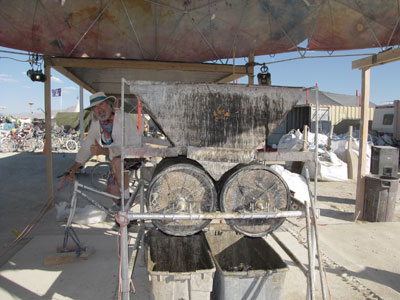
A bicycle-powered can recycling facility is located near Center Camp. This Recycling Camp is staffed by volunteers who participate in the nearly continuous job of crushing and then bagging the cans that Burners bring to them.
The somewhat 'Rube Goldberg' can crushing device employs two horizontal rotatable drums, which are mounted with scant clearance between them. The mechanism to turn them is attached via chain-drive to a bicycle. On which a person – me in the photo to the left – 'rides.'
"Mr. Blue," who is in charge of the recycling done at Burning Man, provided an overview of the program. "At the end we had filled 27 of those large white bags," he told me. "Some were taken to a container that was staged at the DPW Depot, but we had at least 21 still there at the end of the event. The total number of cans collected at Recycle Camp in 2010 was around 148,000. The crusher was built in 2004 and we have crushed very close to a million cans with it in its seven years of operation."
At the time I visited, around mid-week, there were over a dozen of the white, head-high bags filled with crushed cans. If you'd like to see the mechanism in action, to the right is a brief YouTube video I shot while at the Recycling Camp.
Earth Guardians Organization Key to BRC's Ongoing Environmental Success
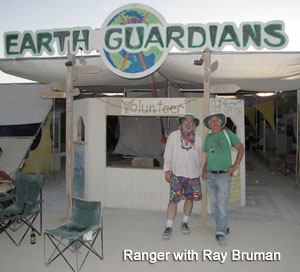
In large part, the extraordinary success of the Black Rock City cleanup has been the result of an organization within Burning Man called "Earth Guardians." While there, I spoke to one of their long-time volunteers, Ray Bruman. In addition to talking with me about his organization while I was in camp, he also provided me with a variety of the links, maps and other information in this article via email as I was writing this article. (Thanks again, Ray!)
The Earth Guardians group was formed in 1997 to inspire the evolving Burning Man community to embrace Leave No Trace (LNT) principles and practices. However, Bruman explained that the group really came into its own after the 1998 Burning Man when rain delayed the cleanup by creating a huge MOOP mess that proved challenging to remove with the then-current methods being used.
Today, volunteer Earth Guardians' members provide information on all aspects of environmental cleanup at their encampment. Members of the organization also visit the Black Rock Desert outside of the Burning Man event times, both to introduce participants to the beauty of the area and to instigate and participate in a variety of restoration and education activities. Many of events are inspired, Bruman told me, by the concepts initiated and taught by the Leave No Trace organization.
Clean-up First Step: Removing the Big Stuff – City Deconstruction
The first effort is to remove all the big structures. DPW utilizes a volunteer crew to take down and remove all of the larger Black Rock City structures. Most of the city infrastructure (all the street signs, lamp posts, paper burning barrels and sculpture burn platforms) must be taken down and removed from the playa. Next, any large debris from theme camps and art installations are removed. Any Burners who haven't yet left the playa are also removed...
In recent years DPW has refined its processes for storage, as well as inventory, of the staging of materials and items in containers, with an eye toward reusing them in subsequent years. Systems are now in place to track everything that goes through the gates of the ranch and storage facility, which is located 12 miles north of the event site.
Second Step: Move Operations Off Playa and Remove Debris
Once most of the city is dismantled, DPW removes its operations off the playa. The DPW structures and equipment are relocated from the playa out to the Burning Man properties. From that point onward in the cleanup effort, crews commute back each day to remove all remaining items from the playa.
Restoration Crew volunteers often remove things that participants don't always prepare to leave no trace with, like oil drips from their vehicles; or bark and wood splinters from construction; or wood piles. After failed attempts to remove them, some Burners have tried to bury their tent stakes in order to give the appearance of leaving a spotless, LNT camp.
What they don't realize is that tent stakes and rebar – which can be hard to remove since even tent stakes are recommended to be 12"-to-18" rebar – pose a serious safety hazard for any subsequent playa visitors even when pounded far underground. Even when pounded far below the surface, a stake will slowly, inevitably, emerge from the playa. (Even when visible, stepping onto rebar tent stakes are the most commonly cited accident. Burners are advised to put tennis balls or other 'soft' covers onto all stakes.)
Despite the collective outreach efforts to Leave No Trace and pack everything out, some debris are left behind each year. The Restoration Crew still finds random abandoned sofas, an occasional bicycle; even an abandoned camp now and then. These items, although only left by a few careless Burners, make the Restoration Crew's job that much harder and time-consuming. The Restoration Crew removes absolutely everything: all "hot spots" like burn scars, fireworks debris, splinters, sawdust and wood debris. They are commonly armed with brooms, rakes, shovels and their bare hands.
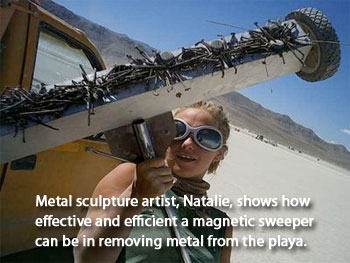 One tool that has proven indispensable for removal of metal from the playa surface is a magnetic sweeper. Although it won't work on wood or other non-metallic objects, of course, the magnet both speeds restoration and is easier on the backs of those tasked with getting absolutely all material up off the playa.
One tool that has proven indispensable for removal of metal from the playa surface is a magnetic sweeper. Although it won't work on wood or other non-metallic objects, of course, the magnet both speeds restoration and is easier on the backs of those tasked with getting absolutely all material up off the playa.
To accomplish its goal, the Restoration Team is separated into two components. One group, called "The Line," sweep the city from end to end in grid formation. If the Line Sweep Team finds an area that is excessively problematic, they designate the area as a "hot spot," mark it with a cone and continue moving forward. The second group, called "The Cone-Killers," concentrate their efforts on cleaning up and restoring all of the problematic hot spots, such as burn scars, broken glass, fireworks debris, oil spills, grey water spills, etc. Using landscape rakes, shovels, magnet sweepers and their bare hands, they work until the hot spot is cleared spotless and the cone can be removed, aka "the cone is killed."
However, Black Rock City organizers are determined to meet the highest BLM standards in terms of restoring the playa to its pristine state. DPW is ultimately responsible for making this happen. Their techniques for achieving this goal have improved over the years. However, as their skills grow so does the city, as do the tasks at hand. Staying ahead continues to challenge the Restoration Crew. The current time allowed to bring the playa to the required level remains about two weeks unless postponed by wet weather.
Burn Platforms / Burn Scars
For the last several years the community has had the goal of having zero burn scars or fire debris left on the playa. However, DPW has still has had to clean up some fire debris. The Burning Man's community understands the need to prevent the baking of the playa, though, and this desire has lead to some unique and creative methods to prevent scarring. Some work well, while others are still in the experimental stage.
One of the best methods developed by DPW was a burn platform design, first tested in 2005, that was much stronger than any previously used. They are composed of enormous, bowl-shaped hunks of steel, artistically enhanced to look like ash trays. These are based on the salvaged ends of rail tank cars, and result in less leech-though of ashes and smaller debris. These newer platforms also sit up off the playa surface, with high sides that solve the problem of spillage of burning debris onto the playa.
Decomposed granite is placed underneath the metal burn platforms, as well, and this combination is sufficient to protect the natural playa surface from burn scar discoloration. The elevated metal platform with granite underlayment system has become key in protecting the playa from scarring.
The same successes have appeared in some of the large art burns that are now skirted with elevated metal, and DPW and the art team are now providing these examples to incoming artists. So far, it has proven difficult to improve upon these, now time-tested, burn-scar prevention techniques.
Third Step: Gridding – Line Sweeps
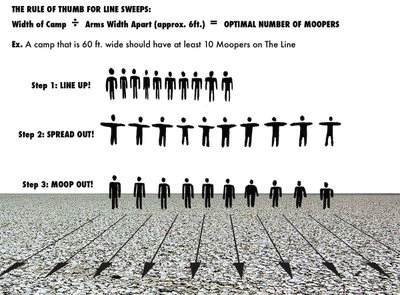
Starting with the 2005 Burn, DPW volunteers began working to spread a "clean as you go" message. This was done by showing those in attendance how line sweeps are done to collect debris. At a particular, scheduled time on one of the days, volunteers demonstrate the technique by walking in a side-by-side line. Everyone is armed with a litter pickup tool, and the educational event is held in a highly trafficked area, between the Man sculpture and Center Camp. The result is that many Burners become even better exposed to the LNT concept. This year, I joined in that educational effort.
At some point during the post-burn cleanup, most items visible from afar are gone. To see what's left, volunteer staff members have to bend over and really look down at the playa in front of them. "Pretty good" is not good enough; DPW's chosen mandate is to make sure that 100% of debris is removed. To do this efficiently, the city is broken down into grids. At the side of each grid, a line of DPW post-burn volunteer crews will set up and slowly walk across the grid, bags in hand, and collect every last twist-tie, nail, bottle cap, piece of string and tent stake.
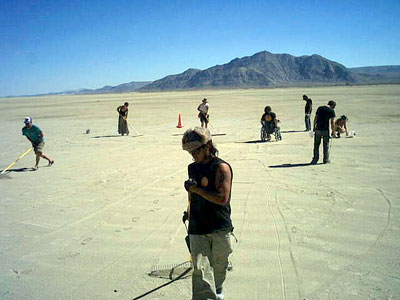 The picture to the right shows the Playa Restoration Team restoring a hotspot, which takes a coordinated effort of most of the basic skills they've been taught to find and remove absolutely everything. In the photo, the dune surface containing that was found to be a 'hot spot' is being raked down dune extensively so any Material Out Of Place will be uncovered for removal.
The picture to the right shows the Playa Restoration Team restoring a hotspot, which takes a coordinated effort of most of the basic skills they've been taught to find and remove absolutely everything. In the photo, the dune surface containing that was found to be a 'hot spot' is being raked down dune extensively so any Material Out Of Place will be uncovered for removal.
These lines typically go into full production starting the second half of September. DPW has worked hard over the years to design these sweeps to allow the crews enough downtime and rest to keep enthusiasm high. In the end, the crew reaps the satisfaction of a job well done, along with a beautiful, empty, clean playa surface.
To make sure absolutely every part of the playa has been swept by the crew, GPS coordinates for large camps, major city installations and common meeting areas are utilized. Any areas around new burn scars are especially scoured for items. As part of its MOOP identification process, each year the Playa Restoration Team publishes a MOOP Tracking Map, which is a scorecard of sorts that shows where the concentrations of MOOP are found. This helps in both designing future prevention in those areas and as a visible notification for campers in that area.
As the 2010 Playa Restoration 'MOOP Map' illustrates, when animated with maps from previous years, attendees this year once again continued the trend of leaving Black Rock City cleaner than ever before. And, as you can see, there has been a tremendous reduction in MOOP since mapping was begun in 2006. For a better view, take a look at the official 2010 MOOP Map on the Burning Man website.
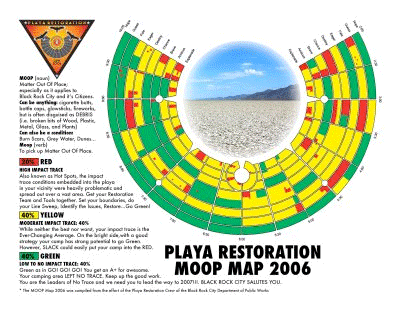
YELLOW = Moderate Impact Trace: While neither the best nor worst, the impact trace is the ever-changing average.
GREEN = Low-to-No Impact Trace: Green as in GO! GO! GO! These camping areas left no trace.
Months from when the last Burning Man event took place, in the spring of the year, DPW volunteers return to check on how the playa has survived the winter rains. Small items that were missed or buried by dust, as well as burn scars, can resurface in spring. All such resurfacing traces of the previous year's Burning Man event are cleaned up. Although the BLM used to conduct an annual spring inspection, the agency dispensed with the need for that a few years ago. However, a spring inspection is necessary for 2011 due to a series of large rain events that occurred right after this year's event. These left the playa impassable during the time period when the BLM's final inspection was to occur.
The Final Analysis
The officially-reported attendance this year was 51,454, up from 43,558 in 2009. I have no doubt that the Bureau of Land Management will eventually find the cleanup results to their satisfaction once again this year, even given the 18% increase in attendance.
However, this year there were severe thunderstorm and rain events after Burning Man was over but before the cleanup could be completely finished. At times, I was told, the Playa had two inches of standing water over top of it. As a result, the final cleanup and inspection had to be postponed. Because of the methodologies that are in place, however, the eventual result is not in doubt. There will be no trace.
You have to be impressed by the educational fervor and hands-on willingness of both volunteers and Burners to go to extraordinary lengths to clean up after themselves. There is also an enormous willingness to help 'newbies' like myself – or anyone else who needed reminding – recognize what might blow away.
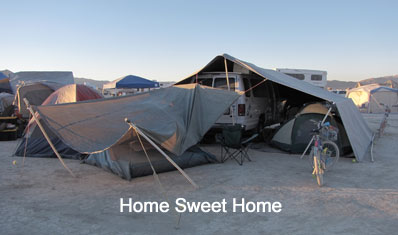
In one instance, prior to when I'd really seen it blow, I received a warning about my tent itself. Later that day when winds hit well over 50 mph I was very glad I had gotten the lesson.I took it to heart and made some changes. Once I'd experienced a real windstorm, I did an even better job of securing everything.
Not only was there a high degree of camaraderie among the participants; in addition, there was ongoing education available from anyone you asked. I found a refreshing willingness by virtually everyone to assist those who needed a hand in learning the correct procedures. On that same note, the overall quality of the Burners I met – of whom I am now numbered – was outstanding.
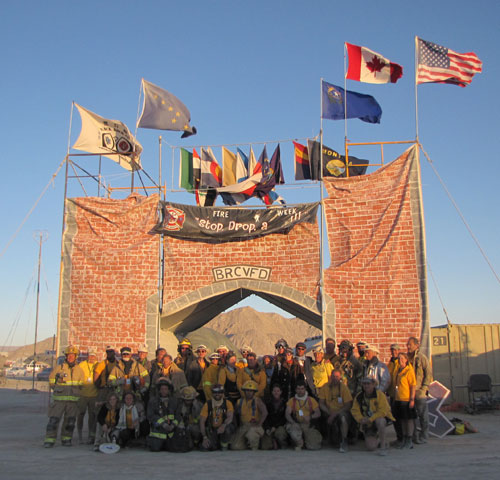
Topping the list were the fire personnel who so graciously allowed the four of us to share their camp. Same could be said of the medical folks who shared our general area, as well.
The health and fire safety of Black Rock City couldn't have been in better hands. It was tremendous fun getting to know everyone, and all were accepting of us. To make that continue, we did our best to help wherever we could, by cooking, doing cleanup and – one of the only ways to keep one's hands clean – doing dishes.
When on shift absolutely all fire and medical personnel were 100% ready and able all of the time; however, we got to enjoy the lighter side of everyone, as well. So many of the guys were participants on "TuTu Tuesday," as just one example, that it (almost) made me wish I'd known to bring one along!
Kudos to all of these emergency team members, one and all!
They even let me run the propane burner on 'Sparky,' the Black Rock City firetruck, during Sunday night's Temple burn. This was especially nice since I'd forgotten to bring my coat. And I'll never forget riding out to the burn of the Man standing on the back bumper of the Fire Chief's pickup truck. You can't imagine the ovation the vehicle and 'I' received on the mile+ journey to the safety perimeter around the Man's burning!
While at Burning Man and since, a number of people who learned about this planned article asked me why I would go to such trouble as to produce this story. After all, the cleanup of Black Rock City is entirely different from the street sweeping and cleanup efforts of any other city in America or anywhere else on the planet.
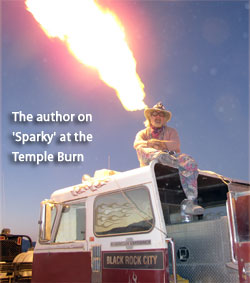 My answer to each was along the lines of "If the public works directors of America and around the world can see what's possible under even harsh conditions like this, my hope is they will be inspired to overcome whatever challenges they, themselves, face in bringing a higher level of environmentally-correct cleanup to their own locales."
My answer to each was along the lines of "If the public works directors of America and around the world can see what's possible under even harsh conditions like this, my hope is they will be inspired to overcome whatever challenges they, themselves, face in bringing a higher level of environmentally-correct cleanup to their own locales."
After all, if these volunteers can garner such success under these harsh conditions, perhaps developing a truly effective street sweeping program for stormwater runoff pollution abatement is attainable in eery town in America and around the world.
Ranger Kidwell-Ross, editor of WorldSweeper.com, is a Masters-level economist with over 20 years of reporting on the power sweeping industry. He is the world's most prolific investigative reporter on the topic of power sweeping and has won numerous writing awards over the last two decades.
Want to experience the Burning Man event through another person's eyes? Use this link to access the well-written overview done by noted graphic designer, Bob Paltrow. Although he and Kidwell-Ross are friends and business associates, neither knew the other was at the event at the time it occurred.
Listen to an audio interview with the man ultimately responsible for playa restoration.
You can hear for yourself what Dominic "D.A." Tinio, head of the Playa Restoration Team, has to say in our 27-minute audio interview with him. Hear for yourself the many challenges the Restoration Team faces, and how they've learned to do the job with precision and success.
Note: The audio interview with D.A. Tinio will play without downloading any files onto your computer. If you hear the interview at 'chipmunk speed,' you will need to download the latest version of Adobe's free Flash player.
Note: To play the interview, click this link or on the small triangle inside the circle you see to the left. If you have any trouble accessing this audio, please let us know.
Dominic "D.A." Tinio is Playa Restoration Manager for Burning Man, and he worked extensively with the author to craft the wording for this article. In addition, D.A. is a noted illustrator located in the San Francisco area, having produced the official Burning Man theme illustrations for 2006 through 2011. You may view these and his other works at the Burning Man website by clicking here, or at his website, www.dominictinio.com. D.A. may be reached via email sent to da@burningman.com. The main Burning Man website is located at www.burningman.com.
Ranger Kidwell-Ross, editor of WorldSweeper.com, is a Masters-level economist who has over 30 years of experience in providing a variety of consulting services to the business community. He is the author of the award-winning book "The Rise of BioDiesel," and co-author of a recently released book on socio-economics entitled "The Great Prosperity of 2020." He is also the world's most prolific author on the topic of power sweeping.
If you have questions or comments about this interview, please, let us know and, if appropriate, we will add them as an addendum to this article. Want to know more about the principles of 'leave no trace?' If so, here is a link that provides the basics of that concept.